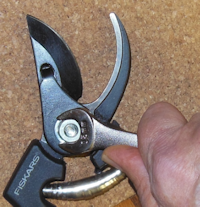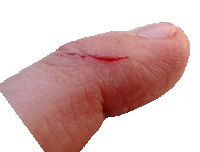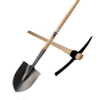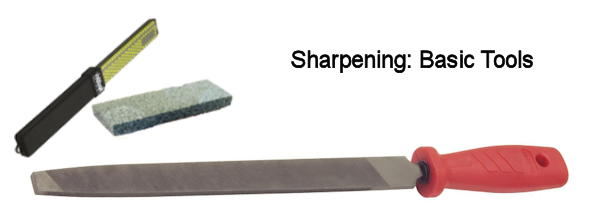Sharp tools are one key to happy gardening. Unfortunately, many gardeners have only experienced the sore hands and arms that come from hacking with dull hoes and squeezing dull pruners.
You will enjoy gardening much more when your tools work as designed, and that is what they will do after you learn how to keep your blades sharp.
Here is how you can do it. Use these guidelines for general practices and then look at the specific instructions found in the tools section. And do not forget to follow the three principles outlined in the previous article, Sharpening Essentials.
Inspect Garden Tool to Determine Needs
Make sure your tool is clean and has no rust. See the articles on cleaning and rust removal for additional information.
Check for any bent parts or parts that need alignment. Pay particular attention to how the blades meet on bypass blades. Repair your tool as needed.
Examine the cutting edges to see if there are any nicks or other damage that will need special attention.
Prepare Tool/Supplies for Sharpening
Dismantle the tool if necessary. This is rare, except for annual care of better hand pruners, but may be needed at times (for example, when there are nicks in the blade that require supporting the tool in a vice for more extensive work).

Choose the proper sharpener for the tool being sharpened:
- 10” mill file (bastard file) for shovels and spades, hoes, and other large blades
- Smaller files for pruners and other small tools (hand size diamond files are ideal)
- Whet stones may be used if preferred
Adjust your sharpening method depending on special needs associated with specific tool qualities or condition. For example, if the blade is very dull or nicked, use a coarser file or stone to shape up the blade. Also, remember that some tools (such as the Felco pruners) are made of especially hard material and require a diamond rather than a steel file.
Proper Way to Sharpen Tools
Sharpen only the edges that should be sharpened on the tool at hand; never put an angle on the back side of a bypass type cutter or the wrong side of a hoe or shovel.
Maintain the proper angle for the tool you are sharpening. Ordinarily this will be the angle of the edge already on the tool. And keep that angle consistent from one end of the blade to the other.
Use long sweeping strokes along the length of the cutting edge, not sawing back and forth in one place which will put grooves in the blade.

In many cases you can first use a coarser file if any significant sharpening is needed and then move on to a finer one. Both the 10 inch steel file I use on larger tools and the pocket sized diamond file I use on smaller ones have two grades, one on each side. Only use the coarser file if necessary.
After the blade is sharp, remove any burrs from the back side of the blade by running the sharpener along the blade holding it flat on the blade.
Special Sharpening Considerations
Most files (but not all) are made to cut in only one direction, so make sure you are using it properly making your cutting move in the direction the file is designed to work.
For major work, such as when you need to cut back far enough to remove a serious nick, reverse the cutting edge on a hoe or shovel sharpened on the wrong side, or put an edge on a new tool that came unsharpened, consider using a power tool if one is available. For example, I use a shop sander to put the first edge on a new shovel. Be careful when using power tools not to overheat the blade.
Make a habit of cutting from the back of the blade toward the sharp edge rather than against it, in other words not so you could run your bare hand into the sharp edge.

A best practice method is to sharpen your tools often when only a few strokes of a fine file is needed. My grandfather was a great gardener with a large garden. His rows were at least 100 feet long. He went out early in the morning to hoe and could be seen regularly as he finished a row or two stopping for a moment as he whipped out his little whetstone and took a few swipes on his hoe. That way he kept his blade sharp—a great model.
Conclusion
Again, sharp tools make gardening more fun. So keep your tools sharp and have more fun. And, actually, sharpening itself is fun in its own way because you get to do a job and then see the results immediately.

